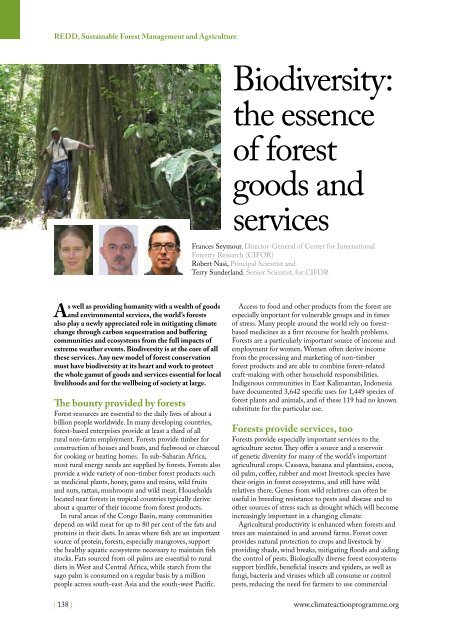Climate Action 2010-2011
Create successful ePaper yourself
Turn your PDF publications into a flip-book with our unique Google optimized e-Paper software.
Redd, Sustainable Forest Management and Agriculture<br />
Biodiversity:<br />
the essence<br />
of forest<br />
goods and<br />
services<br />
Frances Seymour, Director-General of Center for International<br />
Forestry Research (CIFOR)<br />
Robert Nasi, Principal Scientist and<br />
Terry Sunderland, Senior Scientist, for CIFOR<br />
As well as providing humanity with a wealth of goods<br />
and environmental services, the world’s forests<br />
also play a newly appreciated role in mitigating climate<br />
change through carbon sequestration and buffering<br />
communities and ecosystems from the full impacts of<br />
extreme weather events. Biodiversity is at the core of all<br />
these services. Any new model of forest conservation<br />
must have biodiversity at its heart and work to protect<br />
the whole gamut of goods and services essential for local<br />
livelihoods and for the wellbeing of society at large.<br />
The bounty provided by forests<br />
Forest resources are essential to the daily lives of about a<br />
billion people worldwide. In many developing countries,<br />
forest-based enterprises provide at least a third of all<br />
rural non-farm employment. Forests provide timber for<br />
construction of houses and boats, and fuelwood or charcoal<br />
for cooking or heating homes. In sub-Saharan Africa,<br />
most rural energy needs are supplied by forests. Forests also<br />
provide a wide variety of non-timber forest products such<br />
as medicinal plants, honey, gums and resins, wild fruits<br />
and nuts, rattan, mushrooms and wild meat. Households<br />
located near forests in tropical countries typically derive<br />
about a quarter of their income from forest products.<br />
In rural areas of the Congo Basin, many communities<br />
depend on wild meat for up to 80 per cent of the fats and<br />
proteins in their diets. In areas where fish are an important<br />
source of protein, forests, especially mangroves, support<br />
the healthy aquatic ecosystems necessary to maintain fish<br />
stocks. Fats sourced from oil palms are essential to rural<br />
diets in West and Central Africa, while starch from the<br />
sago palm is consumed on a regular basis by a million<br />
people across south-east Asia and the south-west Pacific.<br />
| 138 |<br />
Access to food and other products from the forest are<br />
especially important for vulnerable groups and in times<br />
of stress. Many people around the world rely on forestbased<br />
medicines as a first recourse for health problems.<br />
Forests are a particularly important source of income and<br />
employment for women. Women often derive income<br />
from the processing and marketing of non-timber<br />
forest products and are able to combine forest-related<br />
craft-making with other household responsibilities.<br />
Indigenous communities in East Kalimantan, Indonesia<br />
have documented 3,642 specific uses for 1,449 species of<br />
forest plants and animals, and of these 119 had no known<br />
substitute for the particular use.<br />
Forests provide services, too<br />
Forests provide especially important services to the<br />
agriculture sector. They offer a source and a reservoir<br />
of genetic diversity for many of the world’s important<br />
agricultural crops. Cassava, banana and plantains, cocoa,<br />
oil palm, coffee, rubber and most livestock species have<br />
their origin in forest ecosystems, and still have wild<br />
relatives there. Genes from wild relatives can often be<br />
useful in breeding resistance to pests and disease and to<br />
other sources of stress such as drought which will become<br />
increasingly important in a changing climate.<br />
Agricultural productivity is enhanced when forests and<br />
trees are maintained in and around farms. Forest cover<br />
provides natural protection to crops and livestock by<br />
providing shade, wind breaks, mitigating floods and aiding<br />
the control of pests. Biologically diverse forest ecosystems<br />
support birdlife, beneficial insects and spiders, as well as<br />
fungi, bacteria and viruses which all consume or control<br />
pests, reducing the need for farmers to use commercial<br />
www.climateactionprogramme.org












